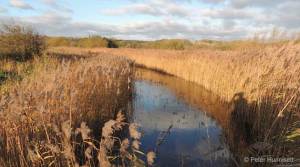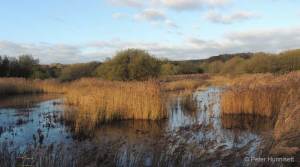Reedbed and Fen

The Country Park contains two reedbeds; one at Bulverhythe at the Southern end of the park, and the other at Filsham at the Eastern end. Filsham Reedbed is the largest in East Sussex (19 hectares or 47 acres) and as well as lying within the Combe Haven Site of Special Scientific Interest (SSSI) it is designated a Local Nature Reserve (LNR) and is managed by the Sussex Wildlife Trust.
Common Reed Phragmites australis dominates both reedbeds although open water and ditches within the Filsham Reedbed are richer in plant life, supporting unusual plants like Frogbit Hydrocharis morsus-ranae, Water Violet Hottonia palustris and the insectivorous Bladderwort Utricularia. Two areas of mixed tall fen, one to the north and one to the south of Filsham reedbed, contain Common Reed, Reed Sweet Grass Glyceria maxima, Gipsywort Lycopus europaeus, Yellow Flag Iris pseudacorus and Purple Loosestrife Lythrum salicaria.

Alder Alnus glutinosa and Sallow Salix cinerea fringe parts of the reed bed and the tall fen community.
The reed and fen areas are valuable for breeding, wintering and passage birds. Breeding birds include Reed Warbler, Sedge Warbler, Lesser Whitethroat, Bearded Tit, Water Rail, Moorhen and Coot. Filsham reedbed is an important stopping-off point for migrant flocks of warblers and swallows and also for rarer species such as Bittern and Marsh Harrier

